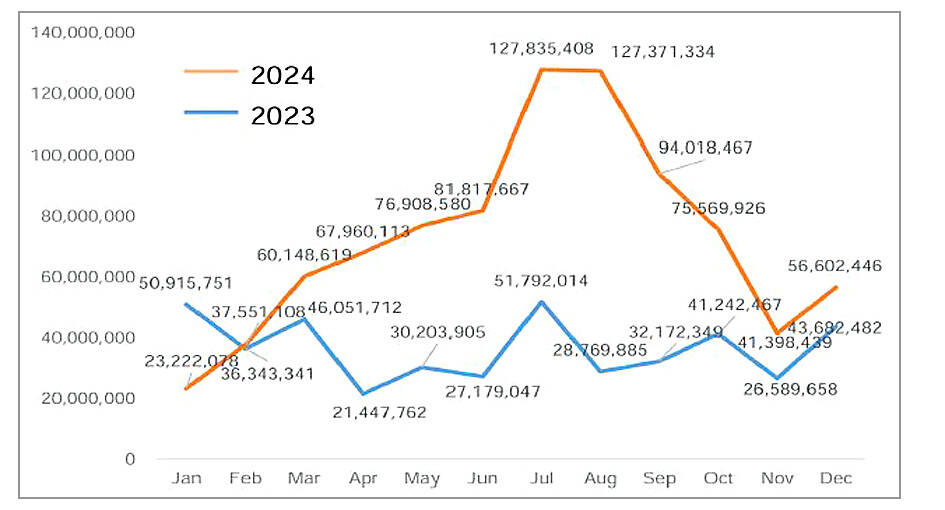Taiwan faced twice as many cyberattacks per day last year compared with the previous year, with the majority attributed to Chinese cyberforces, the National Security Bureau (NSB) said in its latest report.
The government service network registered a daily average of 2.4 million cyberattacks last year, compared with 1.2 million in 2023, according to the report titled “Analysis on China’s Cyberattack Techniques in 2024.”
While most of these attacks were effectively intercepted, the overall situation highlights the increasing severity of cyberattacks, it said.

Photo: Reuters
In the face of the continuous attacks, data theft and disruptions by Chinese cyberforces, the report helps the public understand trends and threats in cybersecurity, it said.
There were 906 cases of cyberattacks targeting the government and private sector last year, an increase of 20 percent from 2023, the agency said.
Government agencies accounted for 80 percent of these cases, it added.

Photo courtesy of the National Security Bureau
There was a 650 percent increase in attacks targeting the communications sector, 70 percent increase in the transportation sector and 57 percent increase in the defense supply chain, the report said.
These sectors have become the key focus for Chinese cyberoperations, which target vulnerabilities in government networks to steal information, the agency said.
Chinese cyberforces last year employed eight primary strategies in targeting Taiwanese entities, it said.
First, they targeted government agencies using “living off the land” techniques to avoid detection and social engineering attacks on public officials’ e-mail accounts, it said.
Second, they used various methods to infiltrate and steal information from Taiwan’s defense supply chain and information service providers, it said.
Third, they targeted critical infrastructure, such as highways and ports, aiming to disrupt the nation’s transportation systems, it said.
Techniques used to accomplish this include advanced persistent threats, phishing e-mails, zero-day vulnerabilities, Trojan viruses and backdoor programs, it added.
Fourth, they collaborated with civilian hacker organizations, employing ransomware and other cybercrime tactics to attack Taiwan’s manufacturing companies for economic benefit, it said.
Fifth, they concealed traces of cyberattacks and stole Taiwanese citizens’ personal data to sell on the dark Web, the agency said.
Simultaneously, they criticized Taiwan’s cybersecurity defenses on social media, undermining national credibility and morale, it added.
Sixth, they combined military exercises with cyberattacks, launching distributed denial-of-service attacks against Taiwan’s transportation and financial institutions to intensify disruption, it said.
Seventh, they targeted high-tech start-ups worldwide to steal patented technologies and gain a competitive advantage, it said.
Lastly, they are building a global stealth cyberattack network, exploiting password vulnerabilities to take control of Taiwan’s Internet of Things devices and make them carry out cyberattacks, it said.
China continues to escalate its cyberoffensives against Taiwan, employing diverse hacking techniques to conduct reconnaissance, plant traps, and steal data from government agencies, critical infrastructure and key private enterprises, it said.
The government leverages a joint cybersecurity defense mechanism and uses multiple intelligence sources to promptly warn responsible departments of any threats, the agency said.
The public should also prioritize cybersecurity measures and remain vigilant against Chinese cyberthreats, working together to safeguard the nation’s overall network security, it added.

The combined effect of the monsoon, the outer rim of Typhoon Fengshen and a low-pressure system is expected to bring significant rainfall this week to various parts of the nation, the Central Weather Administration (CWA) said. The heaviest rain is expected to occur today and tomorrow, with torrential rain expected in Keelung’s north coast, Yilan and the mountainous regions of Taipei and New Taipei City, the CWA said. Rivers could rise rapidly, and residents should stay away from riverbanks and avoid going to the mountains or engaging in water activities, it said. Scattered showers are expected today in central and

People can preregister to receive their NT$10,000 (US$325) cash distributed from the central government on Nov. 5 after President William Lai (賴清德) yesterday signed the Special Budget for Strengthening Economic, Social and National Security Resilience, the Executive Yuan told a news conference last night. The special budget, passed by the Legislative Yuan on Friday last week with a cash handout budget of NT$236 billion, was officially submitted to the Executive Yuan and the Presidential Office yesterday afternoon. People can register through the official Web site at https://10000.gov.tw to have the funds deposited into their bank accounts, withdraw the funds at automated teller

COOPERATION: Taiwan is aligning closely with US strategic objectives on various matters, including China’s rare earths restrictions, the Ministry of Foreign Affairs said Taiwan could deal with China’s tightened export controls on rare earth metals by turning to “urban mining,” a researcher said yesterday. Rare earth metals, which are used in semiconductors and other electronic components, could be recovered from industrial or electronic waste to reduce reliance on imports, National Cheng Kung University Department of Resources Engineering professor Lee Cheng-han (李政翰) said. Despite their name, rare earth elements are not actually rare — their abundance in the Earth’s crust is relatively high, but they are dispersed, making extraction and refining energy-intensive and environmentally damaging, he said, adding that many countries have opted to

PEACE AND STABILITY: Maintaining the cross-strait ‘status quo’ has long been the government’s position, the Ministry of Foreign Affairs said Taiwan is committed to maintaining the cross-strait “status quo” and seeks no escalation of tensions, the Ministry of Foreign Affairs (MOFA) said yesterday, rebutting a Time magazine opinion piece that described President William Lai (賴清德) as a “reckless leader.” The article, titled “The US Must Beware of Taiwan’s Reckless Leader,” was written by Lyle Goldstein, director of the Asia Program at the Washington-based Defense Priorities think tank. Goldstein wrote that Taiwan is “the world’s most dangerous flashpoint” amid ongoing conflicts in the Middle East and Russia’s invasion of Ukraine. He said that the situation in the Taiwan Strait has become less stable